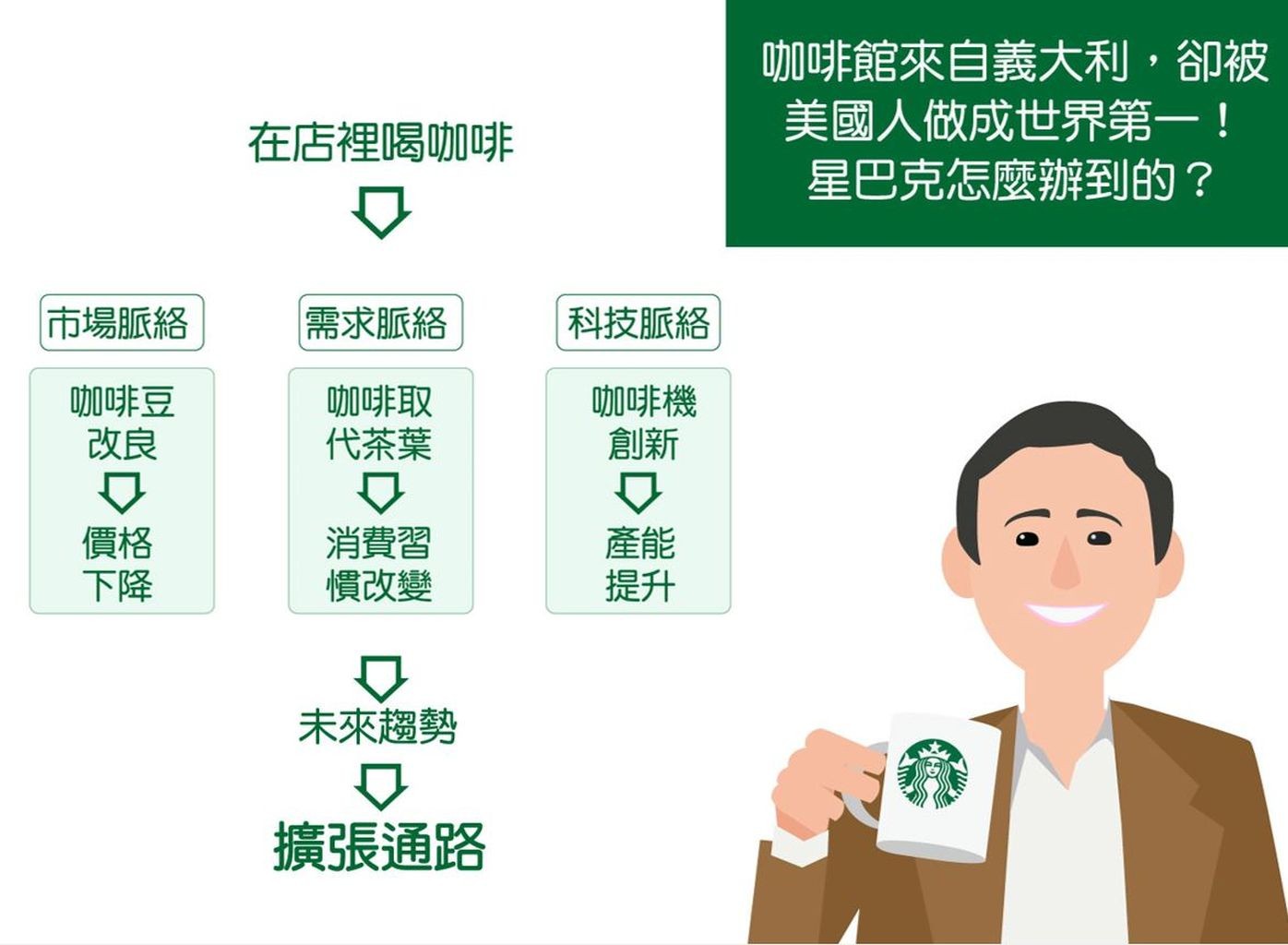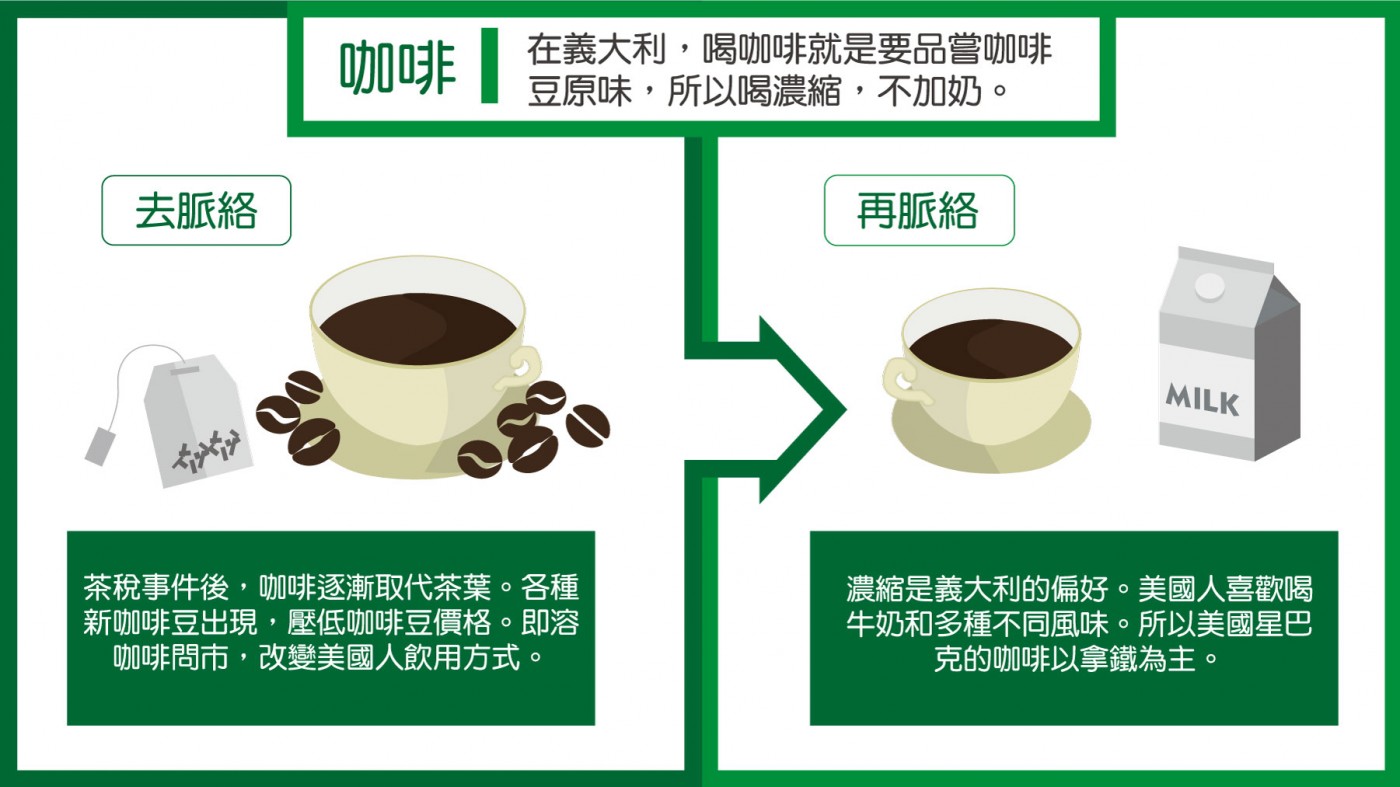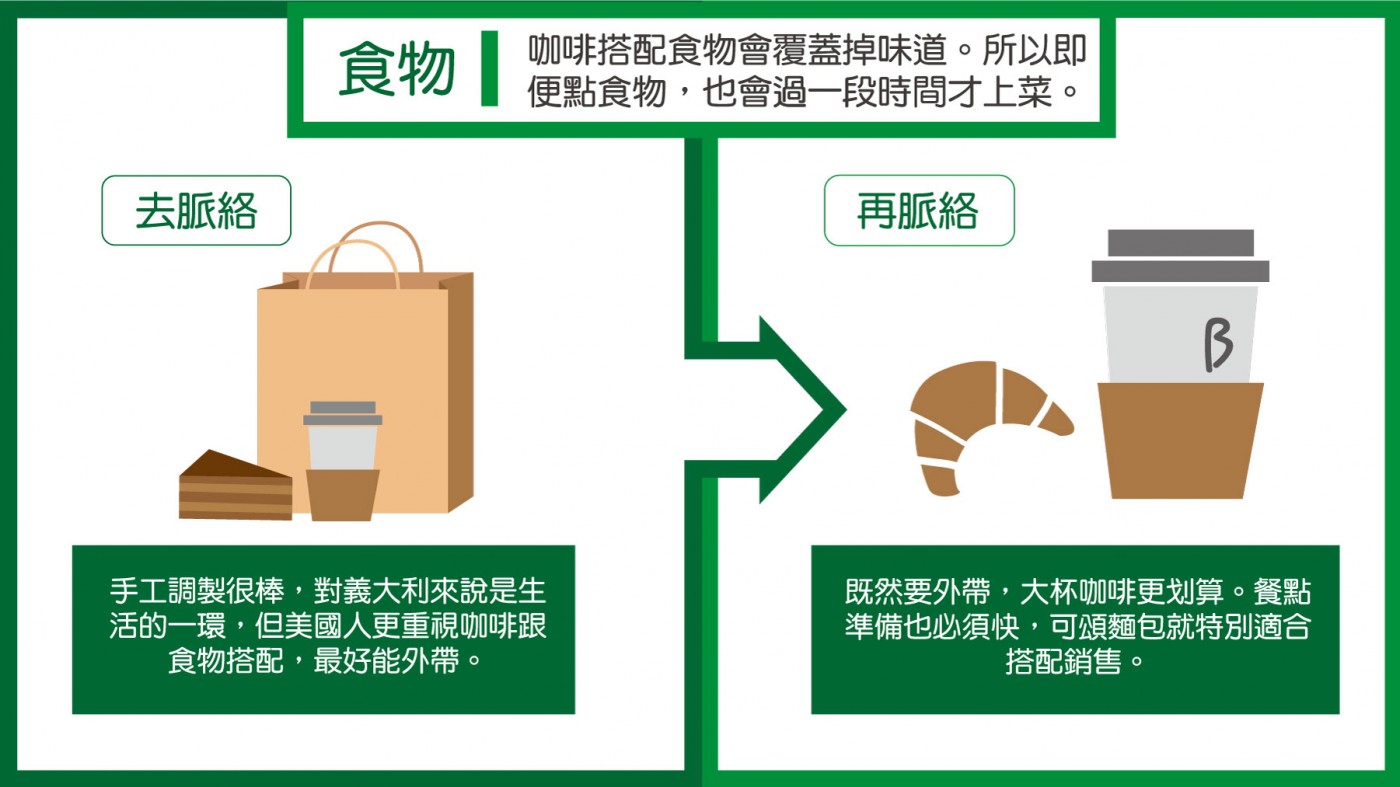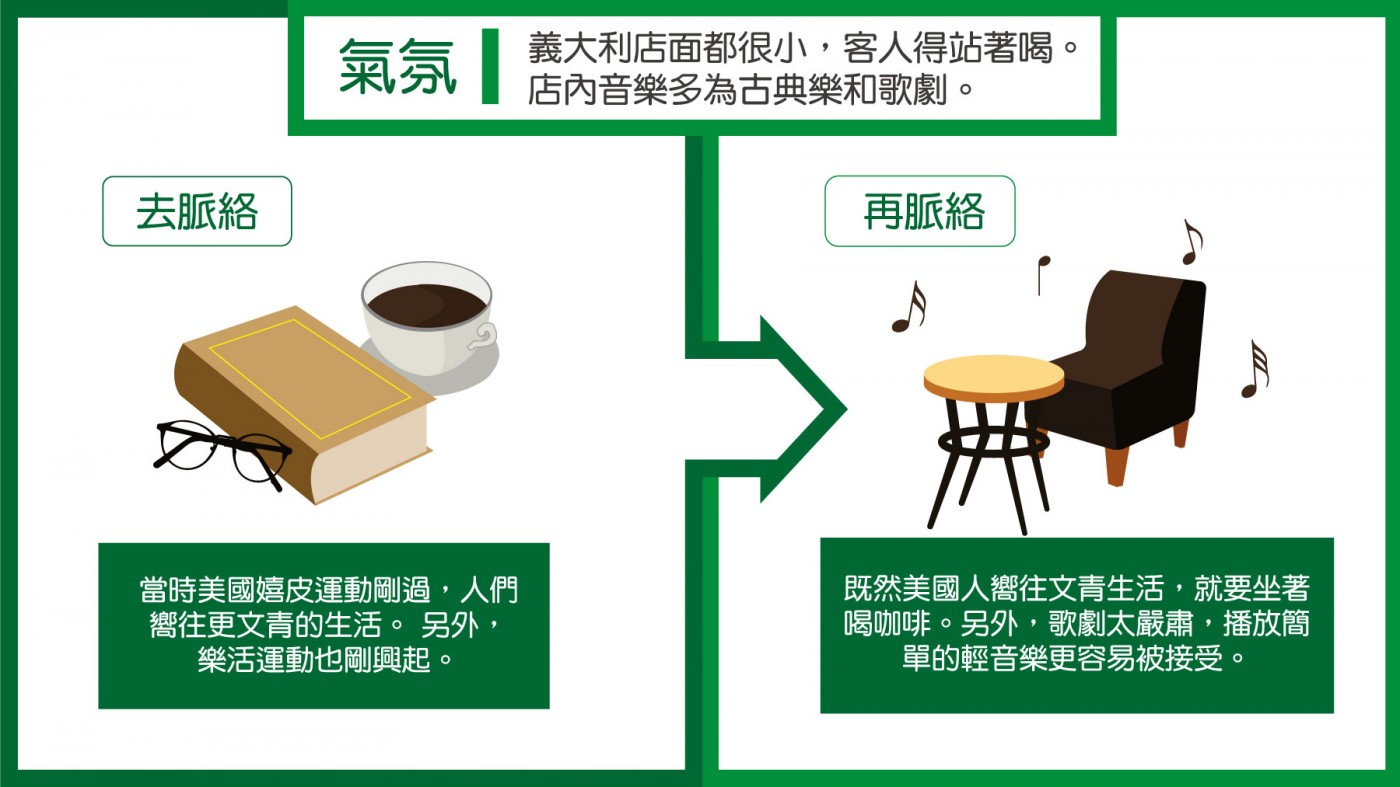Why does Starbucks have no rivals? The key to making the Italian cafe number one in the world
For professional baristas, please follow the coffee workshop (Wechat official account cafe_style)

Huang Hongyi / Cartography
Walking on the streets of Taipei, Shanghai, Seoul, Tokyo, Singapore and London, you can see Starbucks everywhere, as if Starbucks has become synonymous with coffee.
I often think that the concept of Starbucks coffee shop is not difficult to understand, clean and stylish decoration, comfortable background music, free wireless Internet access, these atmosphere make people willing to spend nearly three times more expensive than 7-11 to experience the tranquility of urbanites. The question is, why don't other coffee shops have the charm and scale of Starbucks?
What makes me even more curious is that the innovation of drinking coffee is not strictly speaking the "patent" of the Italian. In Milan, coffee is an art of life, reminiscent of a handsome Italian guy in a formal shirt and bow tie, brewing and pulling flowers gracefully, playing opera as background music, making coffee production itself like a wonderful live performance.
In theory, it is the Italians who should open coffee shops like Starbucks first. How can the Americans take the lead? After doing some research, especially the analysis of Richard Rumelt, a professor at the Anderson School of Management at the University of California, Los Angeles (UCLA Anderson School of Management) and author of "good Strategies and Bad Strategies," I finally understood the context.
Your rigidity, his achievement: is there no market for high-priced coffee in the United States?
In 1983, Howard Schultz was the business manager of a coffee-bean retailer called Starbucks in Seattle.
Once, when Schuz was on a business trip to Milan, he was attracted by the romantic atmosphere of the Italian coffee shop. After returning to China, he also wanted to open a coffee shop of a similar style, so he put forward a proposal to the boss, but it was not accepted. The boss believes that to focus on the retail industry, opening a coffee shop is not the company's strong point. What's more, most of the people who go to the store to drink expensive coffee are hippies and night owls, a niche market.
At that time, the boss of Starbucks only saw the current customers, but not the future customers. He did not see that after the interruption of Anglo-American tea trade, Americans began to replace tea with coffee since 1820. He also did not see that the price of coffee beans began to drop sharply after the emergence of the new variety Robusta coffee, which relatively affected the emergence of instant coffee and changed the coffee drinking habits of Americans. What's more, he didn't see that the Italian Luigi Bezzera invented the pressurized coffee machine in 1901, a technology that allows coffee to interact with steam, greatly shortens the time it takes to brew coffee (increases productivity), and removes the bitter taste of coffee oil.
As a result, Schultz left the company, started his own business, and bought his former employer, Starbucks, in 1987, integrating retail with the store. Starbucks went public with 125 stores in 1992, increased to 4700 in 2001, exceeded 9000 in 2010, grew to more than 20, 000 in 2016, and officially reached 400 in Taiwan in early 2017.
Can not see the context of the needs of users, do not see the context of technological evolution, do not see the context of market changes, can only be lost, empty thoughts.
The cost of replication: it is useless to innovate without the local context.
However, Schuz's entrepreneurial road is not plain sailing, the early opening of the store because of high and few, and suffered a Waterloo. He loves Italian romance too much, but ignores the reality that Americans spend locally.
Starbucks' first-generation store design was a complete replica of Italian style: coffee was served with ultra-small cups of espresso; there were no chairs and customers were expected to stand up and drink coffee like Italians; the background music was opera soprano; the waiter also wore formal clothes and bow ties; if hungry, there were Italian meals to choose from, but it would take a while to serve after the order.
This Italian model doesn't work. Schutz found that customers not only want to sit down and enjoy coffee, but also want coffee to take out, preferably with large or extra large cups. The coffee is not too strong, it is better to add milk or a little more different flavor. The music should not be too serious. It is important to relax. Coffee should feel handmade, but the waiter doesn't have to dress so squeamishly. Finally, customers want to order and serve faster, so they don't need exquisite Italian food, but praise bread. Thus formed the current business model of Starbucks.

Huang Hongyi / Cartography

Huang Hongyi / Cartography

Huang Hongyi / Cartography
Today, Starbucks has found more creative ideas from users, such as the "Starbucks" launched in February 2016, which is said to be put forward by Taiwanese employees, which means accumulating coffee mileage, spending 35 yuan and giving away a star. a total of 66 stars can be upgraded to green star membership and 168 stars to gold star membership, each with different feedback). Before replicating a successful business model, enterprises must not forget to "re-context" the original innovation according to the local context.
In the end, I found that there were many things that "can be done" that many excellent enterprises were unwilling to do.
The old Starbucks owners are unwilling to get out of the comfort zone of retailing; Italian coffee shops are unwilling to go out of the small shop pattern and turn to a chain model, and use financing to accelerate internationalization; Italian companies also feel that Starbucks is not an orthodox coffee shop, but is more like a "coffee seasoning milk" company; the large-market business of coffee beans is too good to do and does not like the "small business" of coffee shops. All the people, no one has seen Starbucks' vertically integrated business model: roasting coffee beans on its own, managing franchised chain stores directly, growing patterns, selling coffee beans to their own coffee shops, adjusting services to meet consumer demand, running their own brands, and so on.
Starbucks' coffee context makes us understand that local context can help us make the transition from "innovation" to innovation, while the ability to succeed in the past may become an obstacle to business growth.
Re-context is like cross-cultural communication, understanding differences can lead to successful innovation.
There are two protagonists in the context of innovation, one is the transmitter of innovation, the other is the receiver of innovation. The process of innovation transfer is like people from different countries have different communication, language and values. Therefore, the messenger must try to understand the recipient's local practices, not mechanically copy it; the receiver also needs to understand the connotation of innovation in order to introduce innovation into the organization.
Step1. Original
Step2. Removal of vein (decontextualization)
Jump out of the specific practices of the original innovative companies and turn innovation into a set of principles. For example, "from A to A +" studies 11 excellent enterprises to work out a common secret of success.
Step3. Re-vein (recontextualization)
After having a common secret of success, improvements need to be made. This is not only to modify the enterprise to match the new model, but also to correct where the secret itself does not apply to the company.
The purpose of the column "thinking context" is to introduce speculative skills in order to explore the source of problems and understand the context of innovation. Each column will list business cases, analyze the successes and failures of various innovations, and trace the context behind them, so as to understand the thinking that makes innovation successful and the myth that innovation fails. )
Important Notice :
前街咖啡 FrontStreet Coffee has moved to new addredd:
FrontStreet Coffee Address: 315,Donghua East Road,GuangZhou
Tel:020 38364473
- Prev

Coffee book recommendation | popular science reader "Coffee Coffee everywhere"
For professional baristas, please follow the coffee workshop (Wechat official account cafe_style). In fact, this book is not the right type to interpret. Because it is only a popular science reader, to put it bluntly, it is for laymen like me to use literacy, and the knowledge involved is relatively simple. However, adhering to the principle of reading and talking as we go through the books, I still want to follow the old rules and
- Next

Can you lose weight by drinking black coffee? it will give you an unexpected effect.
Following Cafe Review (Wechat official account vdailycom) found that Beautiful Cafe opened a small shop of its own. Today, the editor will introduce a black coffee diet to ensure that it will give you an unexpected effect. Black coffee diet, the effect can be seen. The principle of black coffee diet many people will mistakenly think that black coffee is a kind of coffee, and many people say that coffee is not natural.
Related
- What documents do you need to go through to open a coffee shop? coffee shop coffee shop certificate processing process
- How to purchase Coffee beans in small Cafe how to choose a suitable supplier for domestic Coffee supply Company
- How to drink Starbucks Fragrance White Coffee? how to make Australian White Coffee? what Italian coffee beans are recommended?
- The Story of Flora Coffee: the name of Flora Coffee Bean and the implication of the Flowers on Florna Coffee
- How much does a cup of coffee cost? How much is the profit of a cup of coffee? What is the profit of the coffee shop in a year?
- Yunnan small Coffee, known as "fragrant Coffee", introduces the characteristics of Alpine Arabica Coffee producing areas in Yunnan, China
- 2023 latest Starbucks full menu price list how much is a cup of Starbucks coffee what is better to drink the most popular hot and cold drinks recommended
- Starbucks different kinds of Coffee Price list Starbucks menu 2023 Top Ten Best drinks in Starbucks
- Starbucks Spring praise Comprehensive matching Coffee Bean theme Story Packaging implication and taste description
- The cost of a cup of coffee latte American coffee cost price and selling price

